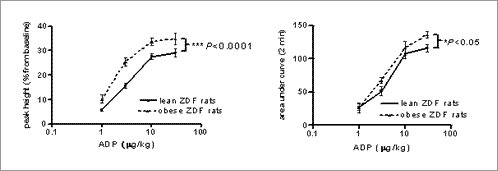Increased platelet aggregation in a rat model of type 2 diabetes Diabetes mellitus in humans is associated with increased arterial thrombotic disease. However, some animal models suggest that platelets in diabetes are similarly or less reactive than control platelets. The aim of this study was to characterise platelet aggregation in the Zucker Diabetic Fatty (ZDF) rat, an animal model of type 2 diabetes. Male lean (fa/+; 265-330g) and obese (fa/fa; 300-370g) ZDF rats aged 11 weeks were anaesthetised with urethane (1.5g/kg i.p.). Aggregation of platelets was measured to ADP in vitro, using Born aggregometry, and in vivo, by 111Indium-labelled platelet accumulation in the thorax using an automated monitoring system. Plasma lipids, glucose, nitrate/nitrite (NOx) and von Willebrand Factor (vWF) antigen levels were also measured. Data are presented as mean ± S.E.M. Statistical analysis was by Student’s unpaired t test or two way ANOVA, as appropriate, with P<0.05 taken as significant.
Table: Rat characteristics. **P<0.01, ***P<0.001 vs. lean rats In vitro , ADP-induced platelet aggregation was not different between lean and obese ZDF rats (n=6). In contrast however, in vivo aggregation responses (peak height and area under curve) to ADP were significantly higher in obese (n=6) compared to lean rats (n=5).
Despite similar aggregation responsiveness in vitro, platelets exhibit higher aggregability to ADP in vivo in obese as compared to lean ZDF rats. This may be the result of the observed differences in the platelet milieu rather than in the platelets themselves, and suggests that platelet hyperaggregability in type 2 diabetes may be caused by factor(s) extrinsic to, rather than intrinsic to, the platelets. |
|||||||||||||||||||||||||


